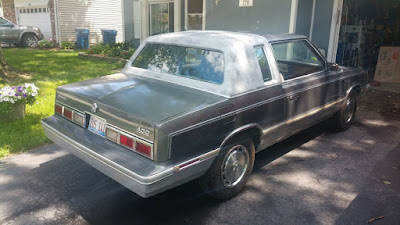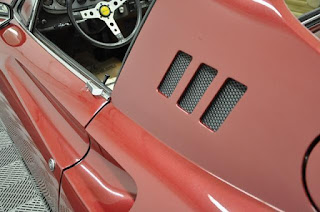Something tells me that if I had been around during the time of the Model T I would have scoffed at the darn seeing how primitive and ugly it was. That would be a shame since I would be disrespecting one of the most seminal automobiles of all time but, hey, "Car Guy" here - we demand more from our rides than their just being basic transportation. Crazy Henry did sell a lot of T's though. Anyway, today we look at another seminal vehicle of sorts, part of the second round of the Chrysler "K cars" that helped save Chrysler, a 1983 Dodge 400.
You wouldn't be alone in never having heard of one of these as the Dodge 400 was only around for two model years and didn't exactly set the world on fire sales wise. Intended to be an upmarket version of the Dodge Aries K, it shared much with the very similar and equally as homely Chrysler LeBaron. The 400 was available only as a coupe.
Part of the allure of attempting to reach middle America and a wide swath of buyers was, allegedly, the K's simple, "honest" styling. I get that, to a certain degree although I think they went a little too far and came up with something that looked like it came out of communist block country. Gussie it up like they did with 70's styling clichés and it always looked like a homely woman with too much makeup on. There had to have been styling wonks at Chrysler who felt the same way. I mean, seriously. Look at this thing.
Part of the allure of attempting to reach middle America and a wide swath of buyers was, allegedly, the K's simple, "honest" styling. I get that, to a certain degree although I think they went a little too far and came up with something that looked like it came out of communist block country. Gussie it up like they did with 70's styling clichés and it always looked like a homely woman with too much makeup on. There had to have been styling wonks at Chrysler who felt the same way. I mean, seriously. Look at this thing.
A fancier, plusher interior and with clichéd exterior styling touches like an "ego thrust" front end and a padded landau top and Ricardo Montalban had a car he might, might, have wanted decked out with Corinthian leather. For the record, Mr. Rork never pitched anything that wasn't branded a "Chrysler" although he did hawk other Chrysler products that weren't Cordoba's. Who could ever forget his series of Chrysler New Yorker ads; the car that talks! Scoff at my beloved Cordoba as you will, at least "our cars" looked like something other than a tissue box on wheels. Even the dreadful 1980-1983 models. Rest in peace, Khan. We miss you.
Chrysler pulled the plug on the 400 after 1983 although it's lilliputian corporate cousin Chrysler LeBaron soldiered on through 1986 before it was redesigned with the jelly bean body that it was most famous for. Chrysler chose to focus their upmarket Dodge Aries K aspirations on the "600", something that was, remarkably, even homelier than the Dodge 400. Built off what was essentially a stretched wheel base K, the "E platform" 600 soldiered on through 1988 before being replaced by another oddly proportioned K car derivative, the Dodge Dynasty.
Much like the Ford Model T, the charm and appeal of all K cars is lost on me and anyone, I believe, who looks at automobiles as something more than mere appliances. All of them, perhaps with the exception of the jelly bean body LeBaron, are just plain terrible looking, handling and cheaply assembled automobiles. Yet people bought them hand over fist. Just like they bought Crazy Henry's Model T.

























